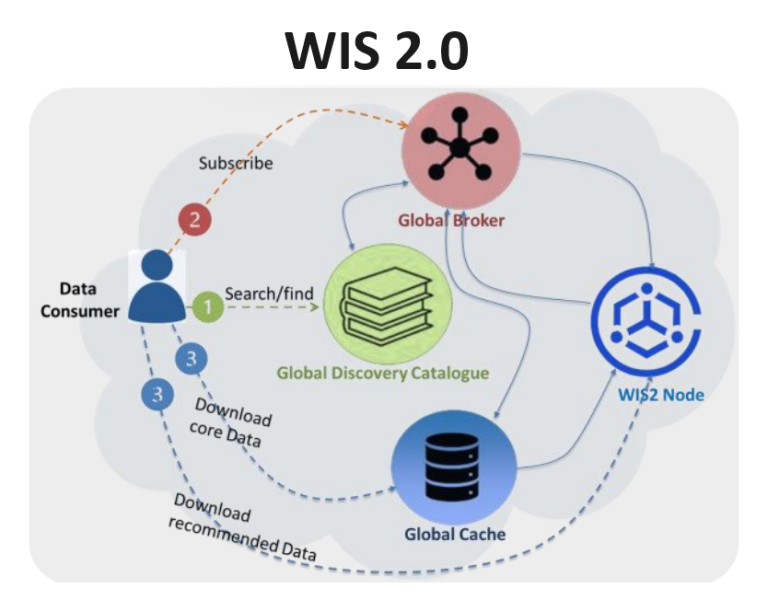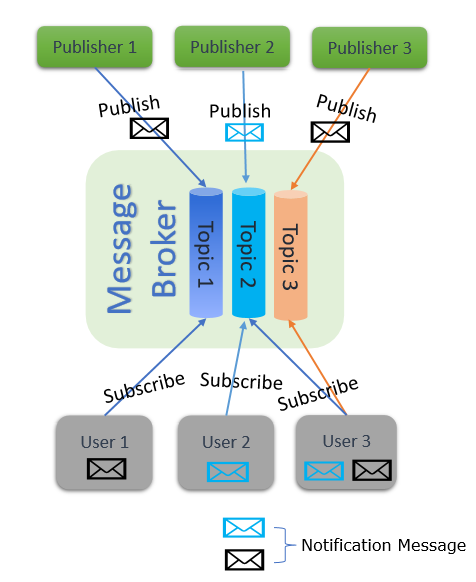WIS2 Overview
The WMO Information System 2.0 (WIS 2.0) has been designed to address the limitations of the current WIS and Global Telecommunication System (GTS). In particular, it supports the WMO’s Unified Data Policy and the Global Basic Observing Network (GBON) while meeting the growing demand for high-volume, high-velocity, and diverse data with strong reliability all all earth-system domains.
Unlike GTS, which relies on private dedicated links, WIS 2.0 leverages the public Internet and employs a publish-subscribe model using the MQTT protocol. This allows users to subscribe to specific topics and receive real-time data updates efficiently.
Each data publisher is required to operate a WIS2 node to publish data and metadata notifications and enable data downloads via HTTP(S).
Navigation: WIS 2.0 Implementation Plan | WIS2 Global Services | What is a WIS2 Node? | WIS2 2.0 Topic Hierarchy | WIS2 Notification Message | WIS2 Discovery Metadata | Setting up a WIS2 Node | WIS2 Node Registration | WIS2 Cookbook | WIS2 Publications Referenced
WIS 2.0 Implementation Plan
Effective 1 January 2025, the WMO Information System 2.0 (WIS 2.0) officially entered its operational phase, marking the start of the transition phase from GTS to WIS2.
For more information on the WIS 2.0 Implementation plan and transition from GTS to WIS2, see https://community.wmo.int/en/GTS_WIS2_Transition_Guidance
WIS2 Global Services
Three types of Global Services are used to enable the dissemination of data in the WIS2 network:
- Global Broker: Provides MQTT(S) Broker that re-publishes data notifications of all WIS2 Nodes. Users of WIS 2.0 will be able to access data in real-time by subscribing to a Global Broker and receiving notifications when new data is available for download from a Global Cache or the data provider WIS2 Node.
- Global Discovery Catalogue: Provides a discovery catalogue, usable through an API or web interface, storing WIS 2.0 Discovery Metadata records. The Global Discovery Catalogue allows users to discover available datasets on WIS 2.0 and provides information on how and where to access the data.
- Global Cache: Provides HTTP(S) server where core data (as defined in WMO Resolution 1) can be downloaded from.
- Global Monitor: Provides monitoring dashboards based on metrics collected from other Global Services and alerting mechanism to ensure 24/7 operations

A data consumer in WIS 2.0 can discover the MQTT endpoints for subscribing to data using a Global Discovery Catalogue. Data classified as "core" as per the WMO Unified Data Policy is available for download without access restrictions from the Global Cache. For data classified as "recommended" data, a data consumer is required to access data directly from the data publisher. Note that recommended data may have access control requirements, which are described in WIS2 discovery metadata.
Each Global Service operator has a centre identifier. For more information, see the Guidance on assigning a centre identifier for Global Services.
What is a WIS2 Node?
A WIS2 Node is a key component of WIS 2.0, deployed by National Centres (NC) and Data Collection or Production Centres (DCPC) to publish their data and metadata notifications efficiently.
A WIS2 Node is composed of two service endpoints that need to be exposed over the public Internet:
- MQTT broker: publishes WIS2 notifications for metadata and data
- HTTP server: enables the download of data and metadata

WIS 2.0 Topic Hierarchy
Data consumers subscribe to specific WIS2 topics to receive notifications on the data type they wish to access.

The topic structure is is consistent with Annex 1 of the WMO Unified Data Policy:

Data announced via a message on origin/a/wis2/<centre-id>/data/core implies free and unrestricted access (as defined in Resolution 1). This data is downloaded by the Global Cache and availability of this data is announced on cache/a/wis2/<centre-id>/data/core.
Access to data announced on origin/a/wis2/<centre-id>/data/recommended may require access control. Data published on this subtopic is not downloaded by WIS2 Global Caches.
For more information, see the Manual on WMO Information System (WMO-No. 1060), Volume II - Appendix D: WIS2 Topic Hierarchy or an approved version of the WIS2 Topic Hierarchy online.
WIS2 Notification Message
The WIS2 Notification Message (WNM) defines the attributes used in the message payload of a WIS2 Notification.
A WIS 2.0 Notification Message contains a "canonical" link indicating the HTTP(S) endpoint from which the data can be downloaded.

For more information, see the Manual on WMO Information System (WMO-No. 1060), Volume II - Appendix E: WIS2 Notification Message or an approved version of the WNM online.
WIS2 Discovery Metadata
WIS 2.0 Discovery Metadata records are encoded according to WMO Core Metadata Profile (Version 2) (WCMP2).
Data producers are required to publish a WIS 2.0 Notification Message on the topic origin/a/wis2/<centre-id>/metadata from their WIS2 Node, containing a canonical link to the WCMP2 record. The Global Discovery Catalogue is updated using the records published on a WIS2 Node's metadata subtopic.
For more information, see the Manual on WMO Information System (WMO-No. 1060), Volume II - Appendix E: WMO Core Metadata Profile (Version 2) or an approved version of the WCMP2 online.
Setting up a WIS 2.0 Node
In order to enable a WIS 2.0 Node for data sharing on WIS2.0, the data publisher needs to set up the following components to be accessible over the public internet:
- Provide an HTTP endpoint for downloading the data advertised in the notifications
- Provide an MQTT broker publishing WIS2 Notifications for data and metadata
- Create WCMP2 compliant metadata records for datasets
- Publish MQTT notification messages to notify the availability of each new metadata record and data granule
In order to accelerate the implementation of WIS2, WMO has supported the development of the "WIS2 in a box" (wis2box) software: a Free and Open Source (FOSS) reference implementation of a WIS2 Node. For more information, see the WIS2 in a box documentation.
WIS2 Node Registration
Registration of a WIS2 Node must be approved by the Permanent Representative with WMO (PR) for the country or territory in which the WIS Centre resides. The National Focal Point (NFP) on WIS matters can register a WIS2 Node on behalf of the PR for an official NC or DCPC listed in the Manual on WMO Information System (WMO-No. 1060), Volume I - Appendix B: Approved WIS Centres.
WIS2 Registration involves the followings steps:
- Request to host a WIS2 Node via WIS National Focal Point (NFP)
- Assign a centre-id: The centre identifier (centre-id) is an acronym as proposed by the Member and endorsed by the WMO Secretariat. (See the Guidance on assigning a centre-id of WIS2 Nodes).
- Complete the WIS2 Register: The WIS NFP shall complete the WIS2 Register operated by the WMO Secretariat (using this form)
- Provide Global Service details: The WMO Secretariat provides connection details for the Global Services (e.g. IP addresses) so that the WIS2 Node can be configured to provide the access.
- WIS2 Node assessment: The principal GISC conducts the assessment and verifies that the WIS2 Node is compliant with WIS2 requirements.
- Add new centre to WIS2: GISC notifies WMO Secretariat and confirms that this WIS2 Node can be added to WIS2
- Communicate details to the Global Services: WMO Secretariat provides the WIS2 Node connectivity details to the Global Brokers to subscribe to the WIS2 Node.
More guidance can be found in the Guide to the WMO Information System (WMO-No. 1060), Volume II - 2.6.1.1 Registration and decommissioning of a WIS2 Node
To register a new WIS2 node in the WIS2 Global Registry, please use this this Microsoft Form
- Note 1: ONLY WIS2 Node registrations submitted by PR or NFP on WIS matters will be considered.
- Note 2: ONLY an operational WIS2 Nodes can be registered in the Global Registry. To be considered operational, your WIS2 Node needs have a publicly available MQTT-endpoint that is regularly publishing WIS2 Notifications to pass the initial WIS2 Node assessment by your GISC.
- Note 3: If your WIS2 Node is not yet operational, we recommend contacting your principal GISC for guidance and support before submitting this form.
- Note 4: If you wish to register your centre-id in the WMO Codes Registry before your WIS2 Node is operational, please contact us at wis2-support wmo [dot] int (wis2-support[at]wmo[dot]int)
wmo [dot] int (wis2-support[at]wmo[dot]int)
- Note 5: With the completed form, the Secretariat will inform your principal GISC to begin the WIS2 Node assessment.
- Note 6: Once your WIS2 Node passes the assessment, the WMO Secretariat will notify the Global Brokers, who will then subscribe to your WIS2 Node and begin re-publishing your notifications across the WIS2 network. Your WIS2 Node will then be listed in the Operational WIS2 nodes.
WIS 2.0 Cookbook
The WIS 2.0 Cookbook provides various code snippets, recipes and workflow examples in support of WIS2 requirements.
Click here to view the latest stable release of the WIS2 Cookbook
Updates to this cookbook will be published twice per year - in March and October. All "recipes" published in this cookbook have been reviewed by experts from the INFCOM Standing Committee on Information Management and Technology (SC-IMT). Publication of a new release is approved by the Chair of SC-IMT.
WIS2 Publications Referenced
- Manual on the WMO Information System (WMO-No. 1060), Volume II -> Read about
- Guide to WMO Information System (WMO-No. 1061), Volume II -> Read about
- Provisions for the transition from WIS 1.0 and GTS to WIS 2.0 (WMO-No. 1323) -> Read about
- Manual on the WMO Information System (WMO-No. 1060), Volume I -> Read about
(Last update: 27 June 2025)
